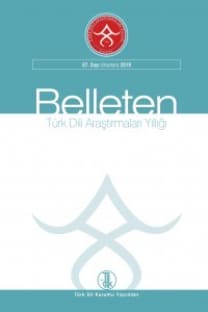ÇİFT ÜNSÜZLE BAŞLAYAN KELİMELERİN YAZIM SORUNU
Bu çalışmada Türkçeye giren çift ünsüzle başlayan kelimelerin yazım sorunu üzerinde
Anahtar Kelimeler:
çift ünsüzle başlayan kelimeler, yazım kuralları, sesçil imla
ÇİFT ÜNSÜZLE BAŞLAYAN KELİMELERİN YAZIM SORUNU
In this study, the problem of spelling of the words beginning with double consonants in thewords that are transferred to Turkish is investigated.Because of the fact that no word in Turkish begins with double consonants, this problemhas been tried to be resolved either by adding a vowel to the beginning of the word as iniskarpin, iskele, istasyon, istatik or by adding a vowel between double consonants as in purova,pılâsman, pılân, pılâstik, purogram. The purpose of doing this was to add a vowel to the wordin order to make the word conforming to the rules of Turkish.This problem was firstly taken into consideration in the Spelling Guide that was publishedby the Turkish Language Institution in 1941. In this guide, the double spelling of these wordssuch as plâsman-pılâsman, plâstik-pılâstik, plân-pılân, program-purogram, prova-purova, statik-istatik is recommended. In the following years, this usage is abandoned. Nevertheless,our authors, poets and important scientists have demonstrated in their essays the actual soundthat appears in talking. This situation is also conforming to the “phonetic” character of Turkishorthography.
___
- Aksan (2005), Prof. Dr. Doğan, Türkçenin Zenginlikleri İncelikleri, Bilgi Yayınları.
- Aktaş (2007), Dr. Ayfer, “Türkçede Almanca Kaynaklı Kelimeler”, Türk Dili, TDK,S. 666, Haziran 2007.
- Akyüz (1975), Prof. Kenan, Denizci Hasan (Yazarı: Ahmet Midhat), Kültür Bakanlığı,1000 Temel Eser: 75, MEB, İstanbul.
- Arat (1979), Reşit Rahmeti, Kutadgu Bilig- Metin, 2. Baskı, TDK.
- Banguoğlu (1941), Dr. Tahsin, Dil Bahisleri-1, Vakit Matbaası, İstanbul.
- Bilgegil (1972), Prof. Dr. Kaya, Harabat Karşısında Namık Kemal, İrfan Yayınları,İstanbul.
- Bostancı (2009), Dr. Gülcan Çolak, “Kraliçe’yi Hecelemek”, Türk Dili, TDK, S. 690,Haziran 2009, Ankara.
- Dizdaroğlu (1972), Hikmet, Muharrir Bu Ya (Yazarı: Ahmet Râsim), MEB, Ankara.
- Ediskun (1963), Haydar, Yeni Türk Dilbilgisi, Remzi Kitabevi, İstanbul.
- Ediskun (2007), Haydar, Türk Dilbilgisi, Remzi Kitabevi, 11. Baskı, İstanbul.
- Eker (2005), Doç. Dr. Süer, Çağdaş Türk Dili, Grafiker Yayınları, 3. Baskı, Ankara.
- Emir (1977), Sabahat, Mektup Yazma Sanatı, Emir Yayınları, İstanbul.Ergin (1992), Prof. Dr. Muharrem, Üniversiteler İçin Türk Dili, Bayrak, İstanbul.
- Gedikli (1999), Yusuf, Asya’da Beş Türk, Yazarı: Adil Hikmet Bey, Ötüken.
- Kaplan (1976), Mehmet, “Nabi ve Orta İnsan Tipi”, Türk Edebiyatı ÜzerineAraştırmalar-1, Dergah Yayınları, İstanbul.
- Karamanlıoğlu (1978), Doç. Dr. Ali Fehmi, Gülistan Tercümesi, MEB, 1. Baskı,İstanbul.
- Korkmaz, Prof. Dr. Zeynep, “Dünya Dili-Bilim Dili ve Türkçemiz Açısından Çözüm Bekleyen Bir Çelişki”, Türk Dili, TDK, S. 630, Haziran 2004. Milliyet, Büyük Larousse, C. 23, S. 11804, İstanbul.
- ISSN: 0564-5050
- Başlangıç: 1953
- Yayıncı: Türk Dil Kurumu
Sayıdaki Diğer Makaleler
ESKİ ANADOLU TÜRKÇESİ ESERLERİNDEN TERTİB-İ MUªĀLECE’DEKİ ORGAN ADLI TIP TERİMLERİ
OBSERVATIONS SUR QUELQUES ASPECTS DE LA PLANIFICATION LINGUISTIQUE TURQUE
GENEL TÜRKÇE BAĞLAMINDA TÜRKİYE TÜRKÇESİNDE ŞİMDİ VE İŞTE SÖZCÜKLERİNİN ETİMOLOJİSİ*
ÇİFT ÜNSÜZLE BAŞLAYAN KELİMELERİN YAZIM SORUNU
